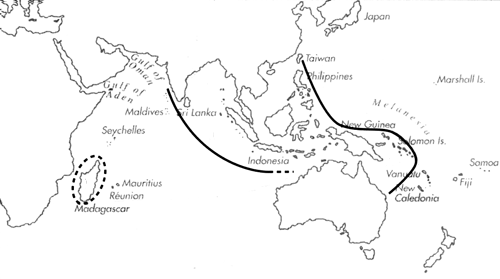
Skip Navigation Links
View access keys for this site.

Range: Range: C. s. suturatus: Papua New Guinea to N. W. Australia and Queensland; C. s. sandwichensis: Hawaii.
Description: C. s. suturatus (Pl. 12, Figs. 1-6): Moderately small to medium-sized, moderately solid to solid. Last whorl conical, ventricosely conical or broadly conical; outline straight or variably convex adapically. Shoulder subangulate to angulate. Spire low, outline concave to straight.
Larval shell multispiral, maximum diameter about 0.7 mm. First 5-8 postnuclear whorls tuberculate. Teleoconch sutural ramps with a pronounced subsutural ridge and a distinct
ribbon between 2 spiral grooves; in large specimens, last ramp sometimes with 3-4 spiral grooves. Last whorl with variably spaced deep spiral grooves at basal fourth to third;
ribs between grading to ribbons adapically.
C. s. sandwichensis (Pl. 12, Figs. 7, 8) differs in its less solid shell with a strictly conical, narrower and more straight-sided last whorl and a moderately high, stepped spire. Subadults from Hawaii have more pronounced sculpture on the last whorl, with spiral grooves extending to shoulder; intervening ribs usually with minute granules.
| Shell Morphometry | ||
|---|---|---|
| L | 30-43 mm | |
| RW | 0.20-0.44 g/mm | |
| RD | 0.62-0.73 | |
| PMD | 0.80-0.90 | |
| RSH | 0.03-0.12 | |
C. s. suturatus: Ground colour white, sometimes suffused with pink or violet. Last whorl usually with 3 orange
or pink spiral bands, below shoulder and on both sides of centre; adapical band usually pale. Sometimes, additional spiral rows of variously sized, squarish, yellowish brown
spots form clusters overlying colour bands; rows vary in number and arrangement and sometimes contain white spots. Base and siphonal fasciole light violet. Larval whorls
white. Teleoconch sutural ramps immaculate or with orangish brown radial markings producing separated spots or bars
along shoulder edge. Aperture white to violet.
C. s. sandwichensis matches C. s. srirurarus in pattern,
except for mostly darker spiral bands on last whorl, a pale orange-brown base, and a usually maculated spire.
Periostracum dark brown, opaque, smooth (Kohn, 1959a: Kohn & Weaver, 1962; Walls, 1978, [1979]).
In C. s. sandwichensis, dorsum of foot white mottled with brown, with a narrow darker band close to the posterior end. Rostrum and tentacles buff. Siphon with 3 broad bands of white, black and tan from the tip proximally (Kohn & Weaver, 1962).
Habitat and Habits: Rare on exposed intertidal parts of coral reef, more frequent in subtidal habitats in 7- 150 m; often on muddy bottoms.
Discussion: C. suturatus resembles C. tessulatus, C. Eburneus and C. kiicumulus. C. burneus can be distinguished by its more equally arranged spiral rows of well separated markings, its white base, and its smooth postnuclear whorls. For comparison with C. kiicumulus and C. tessulatus, see the Discussions of those species.

C. suturatus Range Map
This section contains verbatim reproductions of the accounts of 316 species of Conus from the Indo-Pacific region, from Manual of the Living Conidae, by Röckel, Korn and Kohn (1995). They are reproduced with the kind permission of the present publisher, Conchbooks.
All plates and figures referred to in the text are also in Röckel, Korn & Kohn, 1995. Manual of the Living Conidae Vol. 1: Indo-Pacific Region.
The range maps have been modified so that each species account has it own map, rather than one map that showed the ranges of several species in the original work. This was necessary because each species account is on a separate page on the website and not confined to the order of accounts in the book.
Return to framed version (returns to search page)